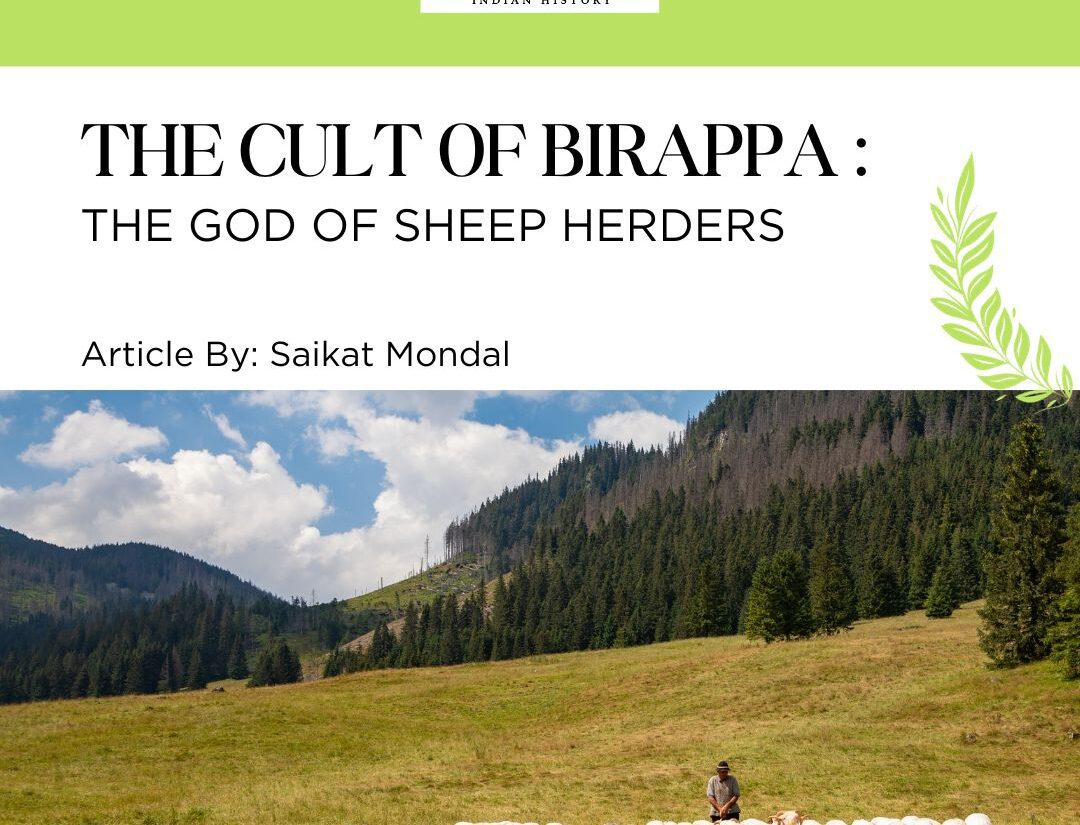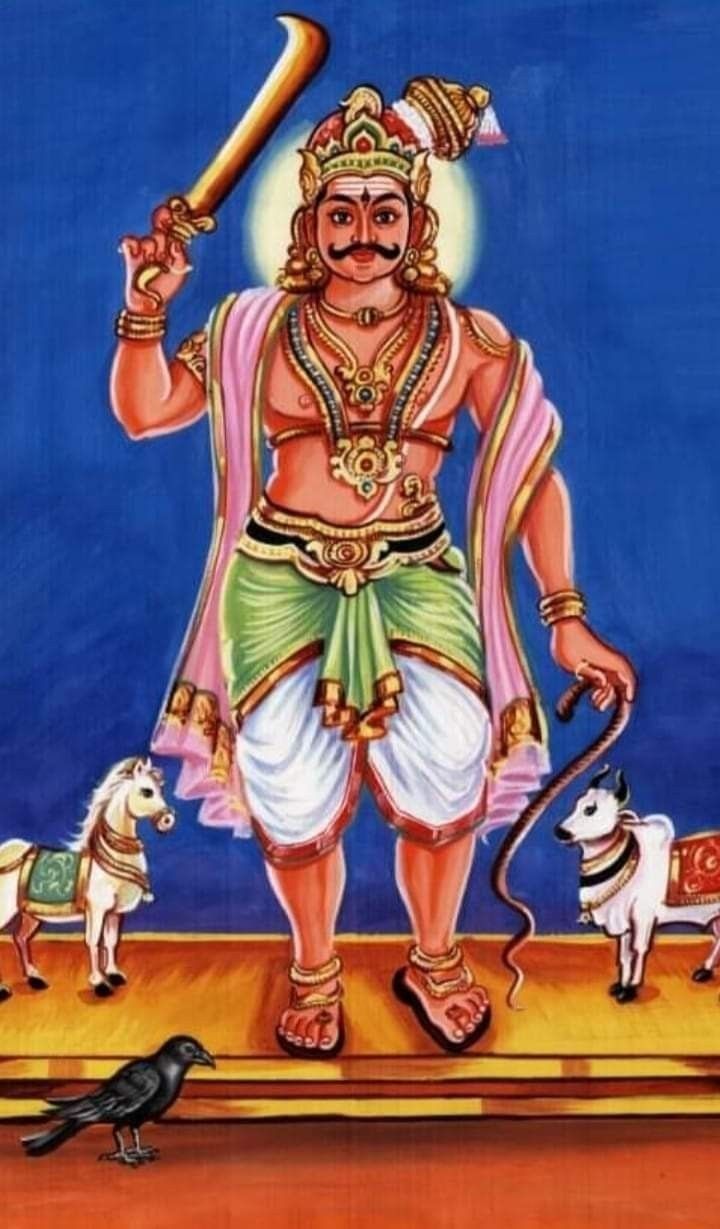
The southern Deccan region, with its semi-arid landscapes, has a rich history of sheep pastoralism that likely dates back to the Neolithic-Chalcolithic period around 3000 BCE. These pastoral communities have their distinct belief systems, attributing their existence and livelihood to divine origins. Shepherds in this region believe that they were specially created by the gods for the specific purpose of rearing sheep, particularly the black Deccani breed. Their favorite deity is Khandoba, also known as Malanna, a god of protection. Legend has it that Khandoba made a solemn commitment during his marriage vows to safeguard not only his second wife, Banai or Banu, a shepherdess, but also all the sheep in the Deccan. Another significant deity in the Deccan pastoralist communities is Biroba, Beerappa, or Beeranna, depending on the specific geographical location. He is regarded as the exclusive god of these pastoral communities and is believed to be the creator of both the sheep and the shepherding communities.
Members of the Kuruba tribes
All of these pastoral communities are worshippers of various forms of Siva or deities associated with Siva. The cult of Birappa has its prevalence among the Kuruvas of southwestern Andhra and Kurubas of Karnataka – is depicted as the chief devotee of Mallikarjuna and in some forms among the Dhangars, Ramoshis, and Matangs of Maharashtra are primarily situated in districts within the rain shadow region of the Western Ghats.
The legend of Birappa
The cult of Birappa sheds light on the early history of pastoral communities and their gods in the Deccan region. Birappa’s mythology, recorded at the shrine of Birappa in Balapālapalle, Kurnool district, narrates his transformation from a human into a divine being. Initially, he was the youngest of seven sons of a Kāpu couple named Ādireddi and Ādemma. He possessed birthmarks signifying his supernatural nature. Birappa’s original name was Elanãgireddi. His jealous brothers sent him to clear land near Šrisailam, believing he would be killed by a demoness guarding the area. However, he defeats the demoness’ children with an axe and upon the Demoness’ complaint to Siva he says that he is Varaputra and the land belongs to him. It was in this land while ploughing he accidentally opened a lid where Siva had kept Sheep who were ruining his house in Kailash and upon seeing this Siva him to rear all the sheep and move to Kalyanpatnam.

The cult of Birappa
Lord deity ‘Birappa’ who is worshipped by the Kuruba Tribe
After some time, Birappa moved to Kalyänapatnam with a herd of sheep but was not allowed into the city due to the residents’ customs. He spent twelve years in the forest with his sheep. The people of Kalyänapatnam worshipped Lord Šiva and Basavanna, the humped bull Nandi. They practised agriculture and they considered the practice of keeping sheep flocks as filthy. Šiva, observing Birappa’s hardship, devised a plan to help him gain acceptance.
Šiva caused one of Birappa’s rams and Basavanna to die simultaneously, shocking the city’s inhabitants. They tried to revive Basavanna through prayers. Šiva instructed Birappa to take the dead ram’s wool to Kalyänapatnam and sell it. However, the people still refused him entry.
Undeterred, Birappa placed the ram on a pyre on the city’s outskirts. As the smoke from the burning ram drifted over Kalyänapatnam, the residents’ rituals to revive Basavanna were considered impure. They threatened Birappa, who challenged them to revive the Nandi or allow him to bring his ram back to life. The people failed, and Birappa, with the help of Revana Siddešvara who sprinkled pasupu (turmeric) and kumkuma (vermilion), miraculously resurrected the ram.
The revived ram ran amuck, causing chaos in Kalyänapatnam. Even the King came in front of the ram and to save his life he and his people agreed to follow Birappa’s traditions. This event earned Birappa respect, and many of the city’s Lingäyats became his followers. Birappa’s prayers and the use of birudulu (a ritual implement) in his devotion to Šiva and because he won the challenge using birudulu Šiva bestowed the title of Biradeva on him, which later became Birappa.
Analysing the Legend
The legend of Birappa begins with a Kãpu couple named Ädireddi and Ãdemma, possibly representing early ancestral communities. Elanãgireddi, one of their sons, is tasked with clearing a forested area for cultivation, reflecting the expansion of agriculture into previously uncultivated regions.
The story involves Elanãgireddi discovering a flock of sheep in the forest, possibly indicating the domestication of sheep or goat species. Elanãgireddi then adopts a nomadic life with his sheep, symbolising the transition to sheep pastoralism. The rejection of Elanãgireddi and his sheep by the inhabitants of Kalyãnapatnam underscores the economic importance of cattle and agriculture in that region.
The conflict between Elanãgireddi’s sheep pastoralism and the settled agricultural community of Kalyãnapatnam is a reflection of the clash between different economic systems. Eventually, Elanãgireddi’s success in reviving his sheep and making the people of Kalyãnapatnam adopt his traditions indicates the superiority of the sheep pastoral system in a semi-arid grassland ecosystem.
Notably, the god Mallikãrjuna has two carriers: a horse for the Kuruvas (associated with sheep pastoralism) and a humped bull for settled agricultural communities. This dual worship suggests the economic division between these groups. The use of horses by Kuruvas reflects their mobility and prestige, indicating that cattle had minimal economic and cultural importance for them.
The Festival of Birappa
The festival of Birappa is celebrated at the Balapãlapalle temple, a modern structure made of bricks and limestone slabs. The sanctum sanctorum is a square room where devotees gather to sing bhajans, accompanied by music, on festival occasions. Birappa is a devout follower of the god Mallikãrjuna, leading the god who sits on a horse.
The festival occurs on the night of Caitra Sudãha Vidiyã and the following two evenings, usually at the end of March or early April. On Caitra Suddha Vidiyã evening, Kuruva men, women, and children dress in their finest attire and travel to the Sunkalamma temple, about 2 km from the village, in decorated bullock carts. Music plays as they make perambulations around the temple, with some women getting possessed. Sacrifices, like immature goats and hens, are offered to the goddess as vows.
After the temple visit, a hunt-like ritual called pãruvêta takes place. Two hares, sometimes replaced by a ram, are released, and villagers chase them. The two who capture the hares or the ram enjoy a feast with their families and friends.
The women return home to prepare for the evening bhajan at the Birappa temple, while the men gather at the village meeting place. Singers perform Telugu songs related to Ramãyana and Birappa’s legend. This continues for about an hour and a half, followed by supper.
Kuruba festival (released rams and chasing men which forms an integral part of the pãruvêta ceremony)
Around 10 p.m., everyone assembles at the temple for the procession. Drums beat, flutes play, and some men get possessed, demonstrating their devotion by fierce actions. The small bronze figurine of Mallikãrjuna, along with Mallikãdevi, is mounted on a wooden horse, which is then placed on an ambhãri (canopy). The procession, accompanied by devotional songs, winds through the village.
Dancing of a Kuruba Men after being possessed upon reaching the outskirts, a ceremonial bath is given to the figurines, and they are anointed with sandalwood paste. Offerings, garlands, coconuts, fruits, and sacrifices are made. The entire night is filled with worship, music, and possessed individuals.
Before sunrise, the procession returns to the village, and another goat is sacrificed. The idols are placed back in the temple, marking the end of the jãtra.
The following day, mokkubadulu (offerings) and uggupãlu (feeding milk to newborn children) take place in front of the temple. The uggupãlu ceremony involves drinking coconut milk from a bowl, kneeling, and using their teeth without spilling a drop. This marks the conclusion of the Birappa festival for the year.
Conclusion
The study of the influence of the cult of Birappa on Southern Deccan pastoralists unveils a tapestry of adaptability, syncretism, and the enduring power of faith in the face of challenges. Pastoralists, who have historically grappled with changing landscapes and agrarian conditions, have displayed remarkable resilience. They have adjusted migratory routes, fluctuated the size and composition of their flocks, and even ventured into new grazing areas, demonstrating their ability to harmonize tradition with practicality. The conflicts faced by these shepherds in the modern era extend far beyond the traditional battles with canine predators. The pastoralists believe that the wolf is a harbinger of good luck. If a wolf lifts an animal from a flock the latter is an offering to Beerappa.In recent times with the change in land use pattern, declining prices of wool upon the advent of synthetic wool, and other complex forces of modern development, they are facing difficulties in maintaining their pastoral lifestyle and some of them shifted to sedentary agriculture others are trying to constantly evolve themselves with modern varieties of Sheep produced by process of Hybridization with various Deccani breeds.
A Kuruba tribesman with his flock of sheep walking a highway in Belgaum Karnataka.
The cult of Birappa, deeply ingrained in the pastoralist communities, stands as a testament to the syncretic values that permeate the region. Notably, this influence extends beyond religious boundaries, as even Muslims venerate these shrines. The narrative of Itthal and Birappa reveals a remarkable confluence of faith, as Muslims consider the temple of Itthal and Birappa to have evolved from the dargah of a Muslim saint. This syncretism is evident in the coexistence of Hindu and Muslim elements in the temple’s architecture and rituals, as well as the presence of a Muslim gravestone at the site.
References
- Bignami, C., 2011. The Indian Huntresses: Nymphs or Goddesses?. The Indian Huntresses: Nymphs or Goddesses?, pp.385-406.
- Burman, J.J.R. (2001) ‘Shivaji’s myth and Maharashtra’s syncretic traditions’, Economic and Political Weekly, 36(14/15), pp. 1226–1234. Available at: https://www.jstor.org/stable/4410485 (Accessed: 15 October 2023).
- Misra, K.K. and Rao, K.K. (2002) ‘Theogamy in rural india: socio-cultural dimensions of the “jogini” system in andhra pradesh’, Indian Anthropologist, 32(1/2), pp. 1–24. Available at: https://www.jstor.org/stable/41919906 (Accessed: 15 October 2023).
- Murty, M.L.K. (1985) ‘Ethnoarchaeology of the Kurnool cave areas, South India’, World Archaeology, 17(2), pp. 192–205. Available at: https://doi.org/10.1080/00438243.1985.9979962.
- Murty, M.L.K. (1997) ‘The god Narasimha in the folk religion of andhra pradesh, south India’, South Asian Studies, 13(1), pp. 179–188. Available at: https://doi.org/10.1080/02666030.1997.9628535.
- Murty, M.L.K. and Murthy, M.L.K. (1991) ‘Bīrappa and mallannā: the emergence of folk gods in the religion of kuruvas and gollas of andhra pradesh’, Bulletin of the Deccan College Research Institute, 51/52, pp. 563–572. Available at: https://www.jstor.org/stable/42930441 (Accessed: 15 October 2023).
- Murty, M.L.K. and Sontheimer, G.D. (1980) ‘Prehistoric background to pastoralism in the southern deccan in the light of oral traditions and cults of some pastoral communities’, Anthropos, 75(1/2), pp. 163–184. Available at: https://www.jstor.org/stable/40460587 (Accessed: 15 October 2023).
- Rangarajan , M., Madhusudan , M.D. and Ghazala , S. (eds) (2014) Nature without borders. ORIENT BLACKSWAN PRIVATE LIMITED. Available at: https://www.researchgate.net/profile/Ghazala-Shahabuddin/publication/265440866_Nature_Without_Borders/links/5eabf720299bf18b958a94ac/Nature-Without-Borders.pdf#page=149.
Image Sources:
- Source: http://oldisrj.lbp.world/Article.aspx?ArticleID=8701
- https://www.facebook.com/174609946055192/photos/beerappa-festival-history
- https://www.facebook.com/photo/?fbid=148055948646893&set=a.147997181986103&locale=hi_IN
- https://www.facebook.com/photo/?fbid=147997258652762&set=a.147997181986103&locale=hi_IN
https://ruralindiaonline.org/en/articles/kuruba-shepherds-lose-their-security-blanket/

















